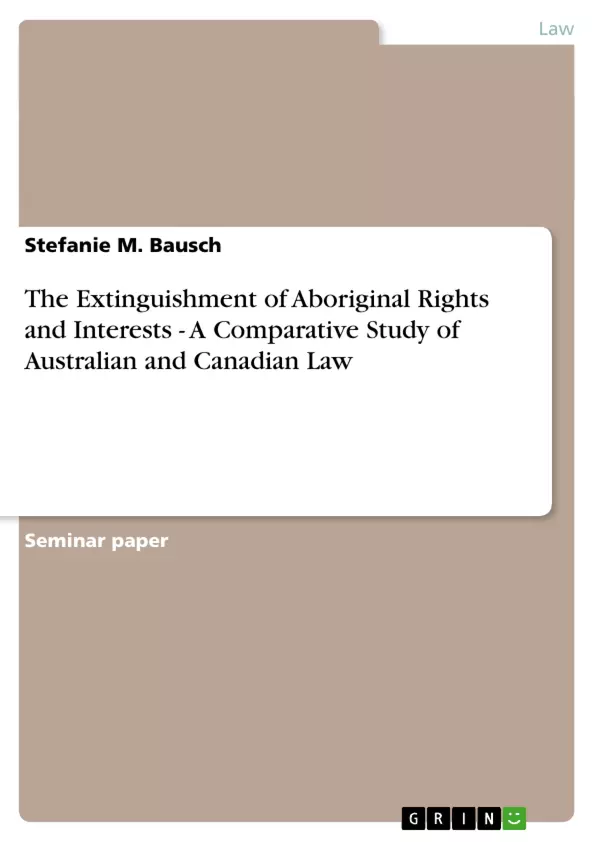“Extinguished is a Latin word. Something is inflamed or on fire, and it is put out. Silenced.
It means to blot out of existence. To totally do away with; to annihilate, cut off, bring to an end. To kill.
The word is related to extinct. That which has ceased to burn or shine. Vanished. Without progressive succession. Having no living representative. There is a vast emptiness.”
The forementioned statement is a quote from Leslie Hall Pinder, a lawyer who represented the claimants in the famous Canadian aboriginal land rights case of Delgamuukw v British Columbia . It is part of a speech Pinder delivered to the British Columbia Library Association Annual General Meeting in April 1991 after the judgment of first instance was handed down by Chief Justice McEachern.
The quote introduces the reader to extinguishment, especially the extinguishment of aboriginal rights and interests and thus to the topic of this research paper. This essay concentrates on two countries: Australia and Canada, and compares their law in relation to extinguishment of aboriginal rights and interests. First, it examines how these two countries approach the subject. Then, the paper draws a conclusion as to the question of similarities and differences between Australian and Canadian law.
Inhaltsverzeichnis (Table of Contents)
- Introduction
- Extinguishment of Aboriginal Rights under Canadian Law
- Common Law
- Calder v Attorney-General (British Columbia)
- History of the Case
- Findings of the Case
- Rv Sparrow
- History of the Case
- Findings of the Case
- Delgamuukw v British Columbia (1997)
- History of the Case
- Findings of the Case
- Calder v Attorney-General (British Columbia)
- Legislation
- Summary of the Extinguishment of Aboriginal Rights under Canadian Law
- Common Law
- Extinguishment of Native Title under Australian Law
- Common Law
- Mabo v Queensland
- History of the Cases
- Findings of the Cases
- Wik Peoples v Queensland (1996)
- History of the Case
- Findings of the Case
- Fejo v Northern Territory (1998)
- History of the Case
- Findings of the Case
- Western Australia v Ward (2002)
- History of the Case
- Findings of the Case
- Mabo v Queensland
- Legislation
- Summary of the Extinguishment of Native Title under Australian Law
- Common Law
- The concept of extinguishment of Aboriginal rights and interests in both countries
- The historical and legal context surrounding the development of these rights and interests
- Analysis of key case law and legislation in both Australia and Canada
- Comparison of the legal approaches to extinguishment in both jurisdictions
- Exploration of the implications of these legal frameworks on Aboriginal peoples and their rights
- The introduction provides an overview of the topic of Aboriginal rights and interests, setting the stage for the comparative study of Australian and Canadian law. It outlines the structure of the work and the key themes that will be explored.
- This chapter examines the legal framework governing the extinguishment of Aboriginal rights under Canadian law, focusing on the development of common law principles and key court decisions such as Calder v Attorney-General (British Columbia), Rv Sparrow, and Delgamuukw v British Columbia (1997).
- This chapter focuses on the legal framework governing the extinguishment of Native Title under Australian law. It explores the evolution of common law principles, examining key cases including Mabo v Queensland, Wik Peoples v Queensland (1996), Fejo v Northern Territory (1998), and Western Australia v Ward (2002).
Zielsetzung und Themenschwerpunkte (Objectives and Key Themes)
This comparative study examines the legal frameworks surrounding the extinguishment of Aboriginal rights and interests in Australia and Canada. It aims to provide a comprehensive overview of the relevant common law principles, legislation, and landmark court decisions in both jurisdictions.
Zusammenfassung der Kapitel (Chapter Summaries)
Schlüsselwörter (Keywords)
This comparative study focuses on key concepts such as Aboriginal rights and interests, Native Title, extinguishment, common law, legislation, landmark court decisions, comparative analysis, and legal frameworks. These keywords provide a comprehensive overview of the primary themes and areas of focus within the work.
- Quote paper
- Dr. Stefanie M. Bausch (Author), 2004, The Extinguishment of Aboriginal Rights and Interests - A Comparative Study of Australian and Canadian Law, Munich, GRIN Verlag, https://www.grin.com/document/29780



